numpy数据类型
在NumPy中,有多种数据类型可用于表示数组的元素。以下是一些常见的NumPy数据类型:
- int - 整数类型,如int8、int16、int32、int64等。
- uint -无符号整数类型,如uint8、uint16、uint32、uint64等。
- float -浮点数类型,如float16、float32、float64等。
- complex - 复数类型,如complex64、complex128等。 bool - 布尔类型,表示True或False。
- object -对象类型,可以存储任意Python对象。 string - 字符串类型,如string_。
- datetime -日期和时间类型,如datetime64。
dtype
检测数据类型
a = np.array([2, 5, 0, 6, 7],dtype=bool)
print(a)
#[ True True False True True]
a = np.array(range(6))
print(a.dtype)
astype
转换类型
b = np.array(range(6))
print("b转换类型后的值为{}".format(b.astype(bool)))
# b转换类型后的值为[False True True True True True]
arange
随机数
c=np.arange(1,6,2)
# [1 3 5]
数组的形状
shape
shape是NumPy数组的一个属性,用于返回数组的维度信息。它返回一个元组,其中的每个元素表示数组在对应维度上的大小
例如:(2,3)
shape属性返回了一个元组(2, 3),表示数组的第一维度大小为2,第二维度大小为3。
reshape
reshape是NumPy数组的一个方法,用于改变数组的形状。它接受一个参数,即新的形状,可以是一个元组或整数列表。reshape方法将返回一个具有新形状的新数组,而原始数组保持不变。
如果在reshape方法中指定的新形状中有一个维度为-1,NumPy将根据数组的大小自动计算该维度的大小。
例如,如果原始数组有12个元素,可以将其重塑为(3, -1),-1将被自动计算为4
import numpy as npa = np.arange(24)
new_a1 = a.reshape((4,6))
new_a2 = a.reshape((2,2,6))print(a)
#[ 0 1 2 3 4 5 6 7 8 9 10 11 12 13 14 15 16 17 18 19 20 21 22 23]
print(new_a1)
# [ [ 0 1 2 3 4 5]
# [ 6 7 8 9 10 11]
# [12 13 14 15 16 17]# [18 19 20 21 22 23] ]
print(new_a2)
#[[[ 0 1 2 3 4 5]
# [ 6 7 8 9 10 11]]# [[12 13 14 15 16 17]
# [18 19 20 21 22 23]]]print(a.shape)
#(24,)
print(new_a1.shape)
#(4, 6)
print(new_a2.shape)
#(2, 2, 6)
np.flatten()
是NumPy数组的一个方法,用于将多维数组转换为一维数组。
np.eyes()
np.eye() 是一个 NumPy 函数,用于创建一个二维的单位矩阵(identity matrix)。单位矩阵是一个对角线上的元素都为 1,其余元素都为 0 的方阵。
np.eye(N) 接受一个整数 N 作为参数,并返回一个形状为 (N, N) 的单位矩阵。每个对角线上的元素都是 1,其他位置上的元素都是 0。
以下是 np.eye() 的使用示例:
import numpy as np# 创建一个形状为 (3, 3) 的单位矩阵
identity_matrix = np.eye(3)
print(identity_matrix)
# 输出
# [[1. 0. 0.]
# [0. 1. 0.]
# [0. 0. 1.]]
在上面的示例中,np.eye(3) 创建了一个形状为 (3,3) 的单位矩阵。该单位矩阵在主对角线上的元素值均为1,其他位置上的元素值均为0。
你还可以通过指定 k 参数来创建具有偏移主对角线的单位矩阵。例如:
import numpy as np# 创建一个形状为 (4,4) 偏移主对角线两位的单位矩阵
identity_matrix = np.eye(4, k=2)
print(identity_matrix)
# 输出
# [[0. 0 1 0]
# [0. 0 0 1]
# [0. 0 0 0]
# [0. 0 0 0]]
在上面的示例中,np.eye(4, k=2) 创建了一个形状为 (4,4) 的单位矩阵,其中主对角线向右偏移两位。因此,在第三行和第四行上的主对角线元素值为1。
np.argmax()/np.argmin()
argmax 是 NumPy 中的一个函数,用于返回数组中最大元素的索引值。
语法:numpy.argmax(a, axis=None, out=None)
参数: a:输入的数组。
axis:可选参数,指定沿着哪个轴计算最大值。如果不提供该参数,则返回整个数组中最大元素的索引。默认为 None。
out:可选参数,用于指定输出结果的位置。 返回值:
如果没有指定 axis 参数,则返回整个数组中最大元素的索引。
如果指定了 axis 参数,则根据给定轴计算每行/列/深度维度上最大元素,并返回相应维度上最大元素所在位置的索引。
以下是使用 argmax() 函数获取数组中最大元素索引值的示例:
import numpy as nparr = np.array([1, 3, 2, 5, 4])
index = np.argmax(arr)print(f"Array: {arr}")
print(f"Index of maximum element: {index}")
# 输出
# Array: [1 3 2 5 4]
# Index of maximum element: 3
在上面的示例中,我们有一个一维数组 [1, 3, 2, 5, 4]。通过调用 np.argmax(arr) 函数,我们找到了该数组中最大数字5所在位置(索引为3)。
import numpy as nparr = np.array([[1, 2, 3], [4, 5, 6], [7, 8, 9]])
indices = np.argmax(arr, axis=1)print(f"Array:\n{arr}")
print(f"Indices of maximum elements along each row: {indices}")
# 输出
# Array:
# [[1 2 3]
# [4 5 6]
# [7 8 9]]
# Indices of maximum elements along each row: [2 2 2]
在上面的示例中,我们有一个二维数组 [[1,2,3], [4,5,6], [7,8,9]]。通过调用 np.argmax(arr,axis=1) 函数,我们找到了每一行中最大数字所在位置(索引)。返回结果为一个一维数组 [2,2.2],其中 [2] 表示第一行最大元素(值为3)所在位置的索引,以此类推。
数组和数的计算
算术运算
import numpy as nparr = np.array([1, 2, 3])add_result = arr + 5
sub_result = arr - 5
mul_result = arr * 5
div_result = arr / 5print(add_result) # [6 7 8]
print(sub_result) # [-4 -3 -2]
print(mul_result) # [5 10 15]
print(div_result) # [0.2 0.4 0.6]平方根和指数运算
import numpy as nparr = np.array([1, 4, 9])sqrt_result = np.sqrt(arr)
exp_result = np.exp(arr)print(sqrt_result) # [1. 2. 3.]
print(exp_result) # [ 2.71828183 54.59815003 810.7788846 ]数组和数组的计算
算术运算
一维数组
import numpy as np# 一一对应做运算
arr1 = np.array([1,2,3])
arr2 = np.array([4,5,6])add_result = arr1 + arr2
sub_result = arr1 - arr2
mul_result = arr1 * arr2
div_result = arr1 / arr2print(add_result) # [5 7 9]
print(sub_result) # [-3 -3 -3]
print(mul_result) # [4 10 18]
print(div_result) # [0.25 0.4 0.5]
多维数组
import numpy as nparr1 = np.array([[1, 2], [3, 4]])
arr2 = np.array([[5, 6], [7, 8]])add_result = arr1 + arr2
sub_result = arr1 - arr2
mul_result = arr1 * arr2
div_result = arr1 / arr2print(add_result)
# [[ 6 8]
# [10 12]]print(sub_result)
# [[-4 -4]
# [-4 -4]]print(mul_result)
# [[ 5 12]
# [21 32]]print(div_result)
# [[0.2 0.33333333]
# [0.42857143 0.5 ]]
统计计算
import numpy as nparr = np.array([[1, 2], [3, 4], [5, 6]])max_value = np.max(arr, axis=0) # 沿着轴0计算每列的最大值
min_value = np.min(arr, axis=1) # 沿着轴1计算每行的最小值
mean_value = np.mean(arr) # 计算整个数组的平均值
std_value = np.std(arr, axis=None) # 计算整个数组的标准差print(max_value) # [5 6]
print(min_value) # [1 3 5]
print(mean_value) # 3.5
print(std_value) # 1.707825127659933矩阵运算
np.dot()函数执行矩阵乘法.T矩阵转置
import numpy as nparr1 = np.array([[1, 2], [3, 4]])
arr2 = np.array([[5, 6], [7, 8]])dot_result = np.dot(arr1, arr2)
transpose_result = arr1.Tprint(dot_result)
# [[19 22]
# [43 50]]print(transpose_result)
# [[1 3]
# [2 4]]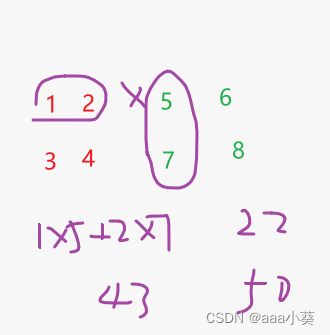
广播规则
当两个数组的形状不同的时候,NumPy会使用广播规则来自动调整数组的形状,以使它们能够参与运算。
广播规则的基本原则是,当两个数组的维度不匹配时,NumPy会尝试通过在缺失的维度上扩展数组来使它们具有相同的形状。广播的过程是自动完成的,无需手动操作。
import numpy as nparr1 = np.array([[1, 2, 3], [4, 5, 6]])
arr2 = np.array([1, 2, 3])add_result = arr1 + arr2
mul_result = arr1 * arr2print(add_result)
# [[2 4 6]
# [5 7 9]]print(mul_result)
# [[ 1 4 9]
# [ 4 10 18]]import numpy as nparr1 = np.array([[1, 2, 3], [4, 5, 6]])
arr2 = np.array([[1], [2]])add_result = arr1 + arr2
mul_result = arr1 * arr2print(add_result)
# [[2 3 4]
# [6 7 8]]print(mul_result)
# [[ 1 2 3]
# [ 8 10 12]]numpy读取数据
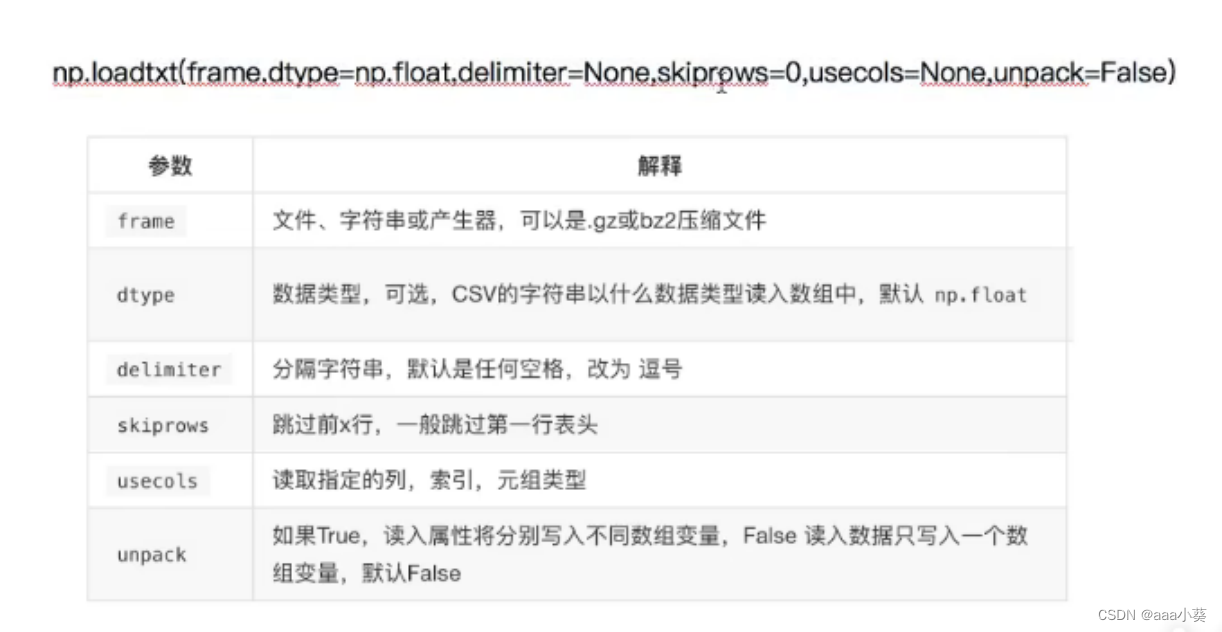
np.loadtxt()函数来读取文本文件中的数据。该函数可以接受文件名作为参数,并返回一个包含文件中数据的NumPy数组
# data = np.loadtxt('data.txt',delimiter=',',skiprows=1)
data = np.loadtxt('data.txt',delimiter=',',dtype='str')
# data = np.loadtxt('data.txt',delimiter=',',skiprows=1,unpack=True)
索引和切片
获取数据
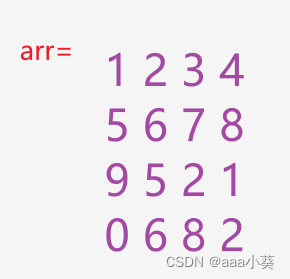
# 第二行
data[2]
# 第二列
data[:,2]
# 2-4行
data[2:,:]
# 2-4列
data[:,2:]
# 1 3 4行
data[[1,3,4]]
# 1 3 4列
data[:,[1,3,4]]
花式索引:获取不连续的多个点
a是一个二维数组,在花式索引中,第一个列表 [1, 1, 3] 表示要获取的行索引,第二个列表 [2, 3, 0]表示要获取的列索引。
代码的含义是获取数组 a 中的 (1, 2),(1, 3) 和 (3, 0) 这三个位置的元素。
a = np.array([[1, 2, 3, 4],[5, 6, 7, 8],[9, 5, 2, 1],[0, 6, 8, 2]
])
t = a[[1, 1, 3], [2, 3, 0]]
print(t)
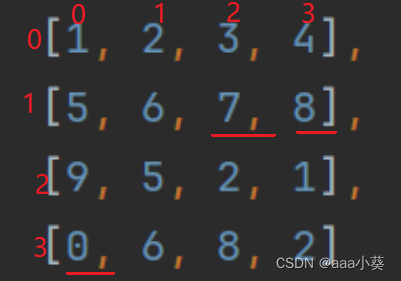
数值修改
a = np.array([[1, 2, 3, 4],[5, 6, 7, 8],[9, 5, 2, 1],[0, 6, 8, 2]
])print(a < 5)
# [[ True True True True]
# [False False False False]
# [False False True True]
# [ True False False True]]print(a < 5)
a[a < 5] = 0
print(a)
# [[0 0 0 0]
# [5 6 7 8]
# [9 5 0 0]
# [0 6 8 0]]
where
np.where(condition, x, y)
import numpy as np# 示例1:根据条件选择元素
a = np.array([1, 2, 3, 4, 5])
b = np.where(a > 2, a, 0)
print(b) # [0 0 3 4 5]# 示例2:根据条件选择元素,同时处理多维数组
c = np.array([[1, 2, 3],[4, 5, 6]])
d = np.where(c > 3, c, -1)
print(d)
# [[-1 -1 -1]
# [ 4 5 6]]# 示例3:根据条件选择元素,同时处理多个数组
x = np.array([1, 2, 3, 4, 5])
y = np.array([10, 20, 30, 40, 50])
z = np.where(x > 3, x, y)
print(z) # [10 20 30 4 5]
- 在示例1中,我们根据条件 a > 2 选择数组 a 中大于2的元素,对应位置上选择 a 中的元素,否则选择0。
- 在示例2中,我们根据条件 c > 3 选择数组 c 中大于3的元素,对应位置上选择 c 中的元素,否则选择-1。注意,这里的条件和数组 c
都是多维的。 - 在示例3中,我们根据条件 x > 3 选择数组 x 中大于3的元素,对应位置上选择 x 中的元素,否则选择 y 中的元素。
数组的拼接
np.concatenate
np.concatenate:可以在指定的轴上连接两个或多个数组
np.concatenate([a, b])会将数组a和b按照第一个轴(默认为0)进行连接
a = np.array([[1, 2], [3, 4]])
b = np.array([[5, 6]])res=np.concatenate([a,b])[[1 2][3 4][5 6]]
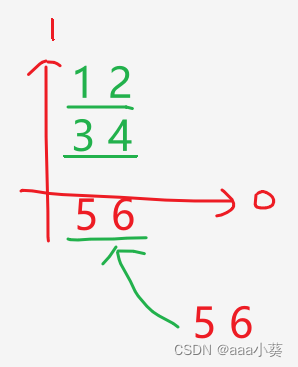
a = np.array([[1, 2], [3, 4]])
b = np.array([[5],[6]])res=np.concatenate([a,b],axis=1)
[[1 2 5][3 4 6]]
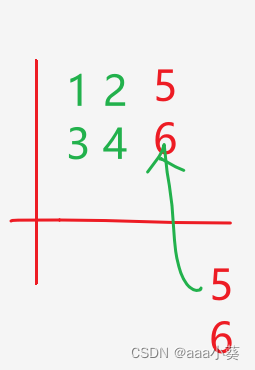
np.vstack
可以垂直(沿着行方向)堆叠两个或多个数组
import numpy as npa = np.array([[1, 2], [3, 4]])
b = np.array([[5, 6]])result = np.vstack([a, b])
print(result)
# 输出
# [[1 2]
# [3 4]
# [5 6]]np.hstack
可以水平(沿着列方向)堆叠两个或多个数组。例如,np.hstack([a, b])会将数组a和b按照列方向进行堆叠。
import numpy as npa = np.array([[1], [2], [3]])
b = np.array([[4], [5], [6]])result = np.hstack([a, b])
print(result)
# 输出
# [[1 4]
# [2 5]
# [3 6]]np.dstack
可以深度堆叠两个或多个三维数组。例如,如果有两个形状为 (M,N) 的二维数组 a 和 b,则 np.dstack([a, b]) 会返回一个形状为 (M,N,2) 的三维数组。
import numpy as npa = np.array([[1,2],[3,4]])
b = a * -1result= np.dstack((a,b))
print(result)
# [[[ 1 -1]# [ 2 -2]]# [[ 3 -3]# [ 4 -4]]]
np.column_stack
可以将一维的列向量转换为二维的列,并且能够水平地连接它们在一起。它等效于 hstack 只不过对于 1D 数组工作得更好.
import numpy as nppx= npp.arange(10)
y= npp.arange(10,20)result = npp.column_stack((x,y))
print(result)
# 输出
# [[ 0 10]
# [ 1 11]
# [ 2 12]
# [ 3 13]
# [ 4 14]
# [ 5 15]
#[6 16]
#[7 17]
#[8
#[9 np.row_stack
就像 vstack只是它通过追加行来工作而不是列
import numpy as npa = np.array([1,2,3])
b = np.array([4,5,6])result = np.row_stack((a,b))
print(result)
# 输出
# [[1 2 3]
#[4 5 6]]numpy生成随机数
- np.random.rand():生成一个指定形状的数组,数组中的元素是从[0, 1)区间内均匀分布的随机浮点数
import numpy as np# 生成一个形状为 (2, 3) 的随机浮点数数组
random_array = np.random.rand(2, 3)
print(random_array)- np.random.randint():生成一个指定范围内整型数据类型的随机整数或整型数组
import numpy as np# 生成一个范围在 [0, 10) 内大小为 (3,) 的一维整型数组
random_int_array = np.random.randint(0, 10, size=(3,))
print(random_int_array)# 可以通过多个参数控制维度和范围,例如:
random_matrix = np.random.randint(low=1, high=10, size=(2, 4))
print(random_matrix)
对于
size=(3,)来说:
- 3 表示数组在第一个维度上有 3 个元素。
- , 表示这是一个只有一个维度的数组。
因此,根据给定的 size=(3,) 参数,生成的数组将是一维、包含三个元素(长度为 3)的数组。
对于
size=(3,1)来说:
- 第一个数字 3 表示数组在第一个维度上有 3 个元素。
- 第二个数字 1 表示数组在第二个维度上有 1 个元素。
因此,根据给定的 size=(3,1) 参数,生成的数组将是一个包含三行、一列的二维数组。
- np.random.randn():从标准正态分布(平均值为0,标准差为1)中返回一个样本或样本数组
import numpy as np# 返回一个标准正态分布样本数组
random_array = np.random.randn(3, 4)
print(random_array)
- np.random.choice():从给定的一维数组中随机选择元素
import numpy as np# 从 [1, 2, 3, 4, 5] 中随机选择一个数值
random_choice = np.random.choice([1, 2, 3, 4, 5])
print(random_choice) # 1# 可以指定选择多个元素和是否允许重复选择,例如:
random_choices = np.random.choice([1, 2, 3], size=(2,), replace=True)
print(random_choices) # [1 3]
- np.random.uniform():从指定范围内均匀分布中返回一个样本或样本数组。
import numpy as np# 返回一个在 [0, 10) 范围内均匀分布的样本数组
random_uniform = np.random.uniform(0, 10, size=(3,))
print(random_uniform)# 可以通过多个参数控制维度和范围,例如:
random_uniform_matrix = np.random.uniform(low=1, high=10, size=(2, 4))
print(random_uniform_matrix)
- np.random.normal():从正态(高斯)分布中返回一个或多个样本值
import numpy as np# 返回满足标准正态分布(平均值为0,标准差为1)的样本数组
random_normal = np.random.normal(size=(3,))
print(random_normal)- np.random.shuffle():随机打乱数组的顺序
import numpy as np# 随机打乱一维数组的顺序
arr = np.array([1, 2, 3, 4, 5])
np.random.shuffle(arr)
print(arr)[5 2 1 4 3]# 可以通过多个参数控制维度和范围,例如:
matrix = np.array([[1, 2], [3, 4], [5, 6]])
np.random.shuffle(matrix)
print(matrix)
[[3 4][1 2][5 6]]
- numpy.random.seed() 函数设置种子
import numpy as npnp.random.seed(123) # 设置种子为 123random_value = np.random.rand()
print(random_value)
输出:
0.6964691855978616在上述示例中,我们使用 np.random.seed(123) 将种子设置为 123。然后,我们调用 np.random.rand() 生成一个随机浮点数,并将结果打印出来。由于我们设置了相同的种子,在每次运行代码时都会得到相同的结果。
通过设置相同的种子值,可以使得每次运行程序时都产生相同的随机序列。这对于需要可重复性和可验证性的实验或模型训练非常有用。
np.copy和np.view
copy()创建一个独立的副本,对副本进行修改不会影响到原始数组。view()创建一个共享内存块的视图,对视图进行修改可能会影响到原始数组
import numpy as nparr = np.array([1, 2, 3])
arr_copy = arr.copy()arr_copy[0] = 10print(arr) # 输出: [1 2 3]
print(arr_copy) # 输出: [10 2 3]import numpy as nparr = np.array([1, 2, 3])
arr_view = arr.view()arr_view[0] = 10print(arr) # 输出: [10 2 3]
print(arr_view) # 输出: [10 2 3]inf和nan
在 NumPy 中,inf(无穷大)和 nan(非数值)是特殊的浮点数常量
inf
inf 表示正无穷大,用于表示超过浮点数范围的值。可以通过使用 numpy.inf 来表示。
示例:
import numpy as npprint(np.inf) # 输出: infx = np.array([1, 2, np.inf])
print(x) # 输出: [ 1. 2. inf]
nan
nan 表示非数值(Not a Number),用于表示不可定义或未定义的结果。可以通过使用 numpy.nan 来表示。
示例:
import numpy as npprint(np.nan) # 输出: nanx = np.array([1, 2, np.nan])
print(x) # 输出: [ 1. 2. nan]
nan 的传播:在进行计算时,如果任何操作涉及到 nan,结果将会是 nan。
示例:import numpy as npx = np.array([1, 2, np.nan])
y = np.array([3, 4, 5])z = x + y
print(z) # 输出: [nan nan nan]w = x * y
print(w) # 输出: [nan nan nan]
比较操作:使用比较运算符(如 <, >, ==)进行比较时,涉及到 nan 的元素会返回布尔值 False。
示例:import numpy as npx = np.array([1, 2, np.nan])print(x < 3) # 输出: [ True True False]
计算函数和 nan:许多 NumPy 中的计算函数对于输入包含 nan 的情况都有特殊处理。这些函数通常会忽略或跳过 nan 值,并返回有效的结果。
示例:import numpy as npx = np.array([1, 2, np.nan])print(np.sum(x)) # 输出: nanprint(np.nansum(x)) # 输出: 3.0
检测 nan:可以使用函数如 np.isnan() 来检测数组中的 nan 值。
示例:import numpy as npx = np.array([1, 2, np.nan])print(np.isnan(x)) # 输出: [False False True]
统计函数
- np.mean():计算数组的平均值
- np.median():计算数组的中位数
- np.sum():计算数组元素的总和
- np.min():找到数组中的最小值
- np.max():找到数组中的最大值
- np.var():计算数组元素的方差
- np.std():计算数组元素的标准差
import numpy as nparr = np.array([[1, 2, 3], [4, 5, 6]])mean = np.mean(arr)
print(mean) # 输出: 3.5median = np.median(arr)
print(median) # 输出: 3.5sum = np.sum(arr)
print(sum) # 输出: 21min_val = np.min(arr)
print(min_val) # 输出: 1max_val = np.max(arr)
print(max_val) # 输出: 6variance = np.var(arr)
print(variance) # 输出: 2.9166666666666665std_deviation = np.std(arr)
print(std_deviation) # 输出: 1.707825127659933

:物理层与数据链路层)
)













:线程状态,线程安全)


